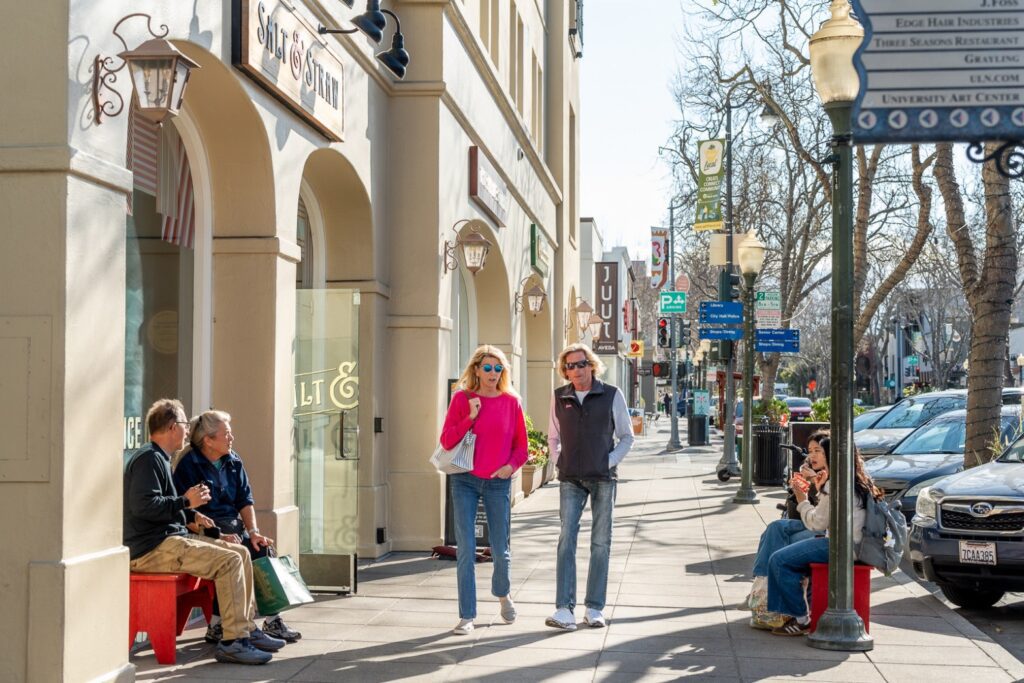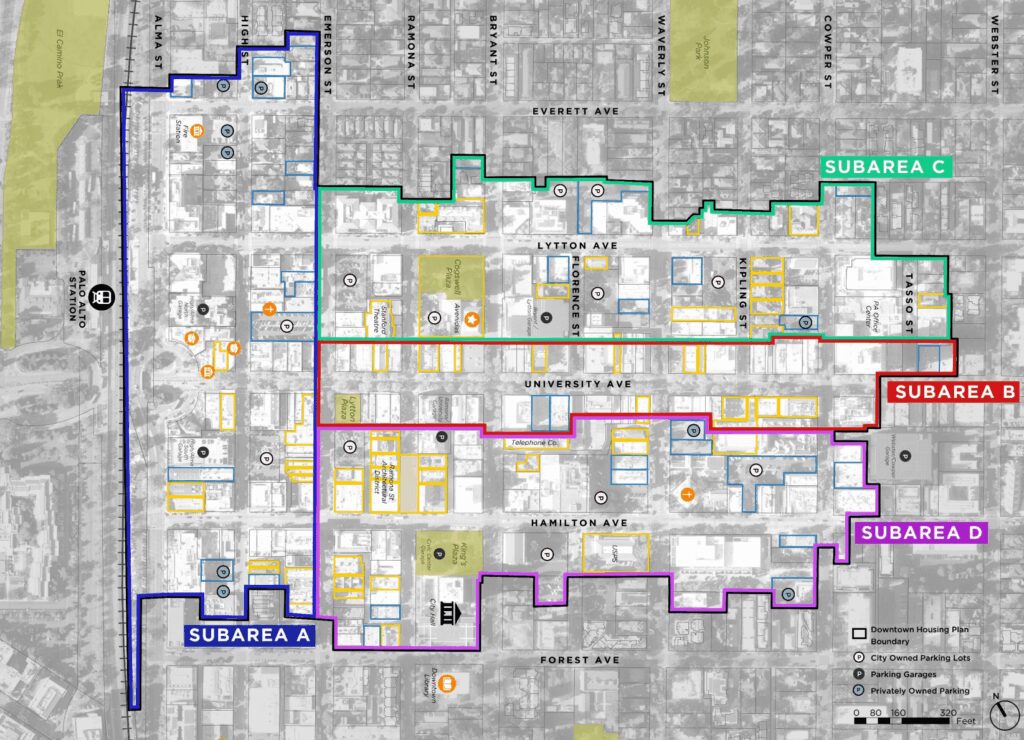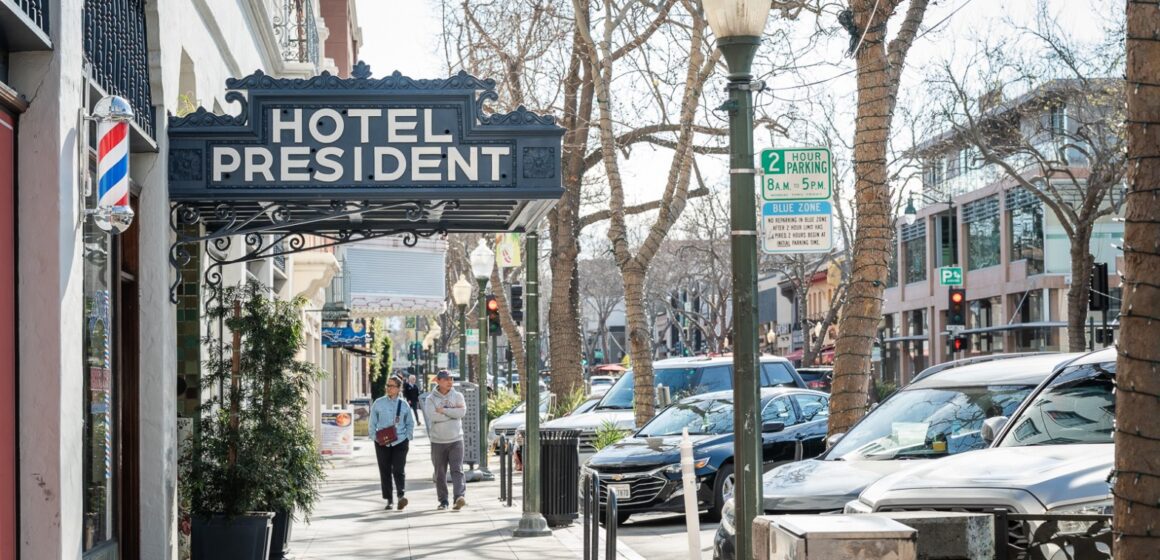As Palo Alto leaders forge a new strategy for increasing housing in the downtown neighborhood, one edge of the 90-acre planning area is emerging as a promising site for a future residential boom.
Downtown has seen virtually no residential growth over the past decade, even as other areas have experienced an influx of proposals. The city’s recently approved Housing Element, which outlines a plan to add 6,086 dwellings by 2031, is notably bearish on downtown housing, saving most of its ambitious programs for commercial corridors in south Palo Alto.
The Downtown Housing Plan aims to change that. Funded by an $800,000 grant from the Metropolitan Transportation Commission, the new plan aims to encourage more housing in the city’s most transit-rich area.
To date, most of the discussions of how exactly to accomplish that have taken place outside public view. The meetings of the specially appointed Community Advisory Group aren’t recorded, and up until earlier this month, most meeting materials had not been posted on the project website.
The downtown plan will be reviewed and refined by a specially appointed Community Advisory Group, which includes Planning and Transportation Commission Chair Allen Akin and Architectural Review Board Chair Kendra Rosenberg, as well as Yadira Aldana, Don Barr, Jennifer Buenrostro, Nancy Coupal, Sudha Fatima, Ken Hayes, Aubrey Merriman, Lee Pfab, Stephanie Wansek and Charlie Weidanz. Developers John Shenk and Brad Ehikian are also on the advisory group.
he project team, which includes staff and consultants from Good City Company, WRT and Consensus Building Institute, held one meeting in June for the broader community, which attracted about two dozen participants, according to meeting records.
In its first meeting, which took place in January, the Community Advisory Group debated the types of housing that should be prioritized downtown. Senior housing emerged as a priority, according to a memo summarizing the meeting, with group members noting the area is particularly lucrative thanks to its proximity to transit services, health care facilities and Avenidas, the nonprofit that operates the city’s senior center.
Group members also “emphasized how downtown living can promote social interaction and better health outcomes for seniors,” the memo states.
Group participants also agreed that in addition to seniors, the plan should prioritize essential workers, service workers and different age groups, according to the memo.

The Downtown Housing Plan’s recently completed assessment report similarly suggests that downtown, with its smaller units, may be well-suited to seniors.
“Surveys show that older residents generally prefer to ‘age in place’ within their homes,” the plan states “However, the large size of the senior population in Palo Alto—and throughout the region as the Baby Boomer generation enters retirement—creates opportunities for development in the Downtown Housing Plan area to capture demand from seniors seeking a walkable, amenity-rich environment with transit options.”
Building the housing, however, is expected to be a heavy lift. At both meetings of the Community Advisory Group, participants grappled with high land costs, small parcels, the dominance of the office market, parking requirements and development standards like the 50-foot height limit and a requirement for ground-floor retail.
A presentation released by the city for the group’s July 1 meeting indicated that the “focal point for density” in the 90-acre planning area could be the section that is closest to the Caltrain corridor. Bounded by Everett and Forest avenues on the north and south, respectively, this subarea on the western edge of University Avenue includes stretches of High and Alma streets.
Participants at the June 18 community meeting favored this area for increased density, according to a staff summary.
The Downtown Housing Plan is expected to take about three years to complete. The community exercise was an early attempt to gather feedback before the City Council discusses the effort in September.
While the council has been on its summer break, city staff and consultants have made some steady progress. Last month, the project team released an assessment that analyzed the downtown area’s housing composition, development standards and resident demographics and identified obstacles to housing construction. It concluded that under current zoning rules, land costs and construction costs, most types of residential construction would be economically infeasible.
One obvious example is the 50-foot height limit, which remains in effect in the downtown area and generally caps buildings at four stories. By contrast, the council has recently raised height limits in certain sections of El Camino Real and San Antonio Road to 85 feet.
Looking to the city’s recent track record for adding housing downtown offers little encouragement. According to the housing assessment, the downtown area has added just seven new housing units since 2013, all as part of mixed-use commercial developments. And it also lost 75 apartments in 2018, when President Hotel was converted from an apartment building to its original function as a hotel.
The current council has been in no hurry to reverse this trend. Even as the city’s recently adopted Housing Element envisions about 2,000 new housing units in the San Antonio area by 2031, the transit-rich downtown neighborhoods are expected to accommodate just 334 dwellings over this period.
The Housing Element’s main programs for the downtown area include modest zoning reforms that allow higher density near transit and a program to build affordable housing complexes on public parking lots.
The Downtown Housing Plan, which the city launched last year, hopes to accelerate the trend. City staff and consultants are now finalizing a pro forma analysis that will consider the economics of building housing downtown, ostensibly with the goal of proposing zoning reforms that would make residential projects pencil out.
In September, the project team plans to present to the City Council a suite of alternatives for distributing housing density within the planning area. The city also plans to hold a community workshop in the fall and finalize its recommendations in November, according to the presentation.

Recently released meeting materials offer a glimpse of how staff and consultants are approaching the Downtown Housing Plan. Rather than make broad zoning changes like on San Antonio Road, the city has been approaching the downtown area as four subareas: the one closest to the Caltrain corridor and three that stretch together from Emerson Street to Cowper Street. The University Avenue subarea is flanked by the two others: the Lytton strip on its north and the Hamilton strip on south.
According to the presentation, key takeaways from the community meeting included a desire to preserve University Avenue’s existing character and ensure “context sensitivity.” That said, there was general support for greater housing density, particularly in the area closest to the rail corridor, and for building housing on public parking lots.
Even though the council has been mostly focusing its housing efforts on south Palo Alto, it has recently made some modest moves in the north. It has already approved the nonprofit Alta Housing as the developer of an affordable-housing complex that would go up on a Lytton Avenue parking lot. At a recent meeting, council members also encouraged Alta to add two stories to its proposed five-story housing project.
Council members also endorsed in April the construction of a new parking structure at 375 Hamilton Ave., which would offset the lost parking from the Lytton site. In doing so, the council majority agreed that the site of the parking structure should also include some housing. Mayor Ed Lauing suggested that failing to do so would be a “waste of some of the most perfect places in town for us to have housing units.”
He also assured the public that the housing-and-parking project is “not just a one off.”
“This is a whole downtown area for which we’re trying to plan and serve,” Lauing said.
In addition to identifying housing opportunities, the downtown plan is expected to consider improvements that may be necessary to help accelerate housing production, Planning Director Jonathan Lait said at an April 24 community meeting focused on housing.
“We want to maintain downtown as an attractive local and regional destination,” Lait said at the April discussion.
This story originally appeared in Palo Alto Weekly. Gennady Sheyner is the editor of Palo Alto Weekly and Palo Alto Online. As a former staff writer, he has won awards for his coverage of elections, land use, business, technology and breaking news.



Leave a Reply
You must be logged in to post a comment.